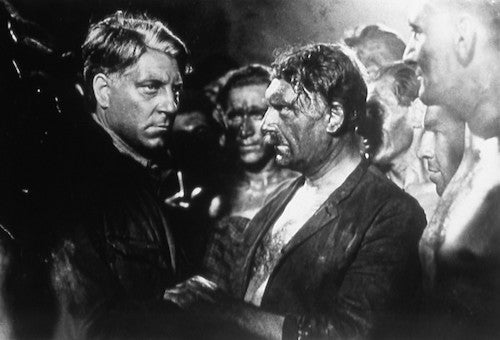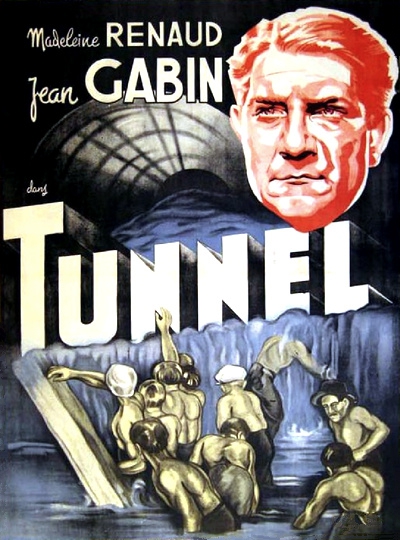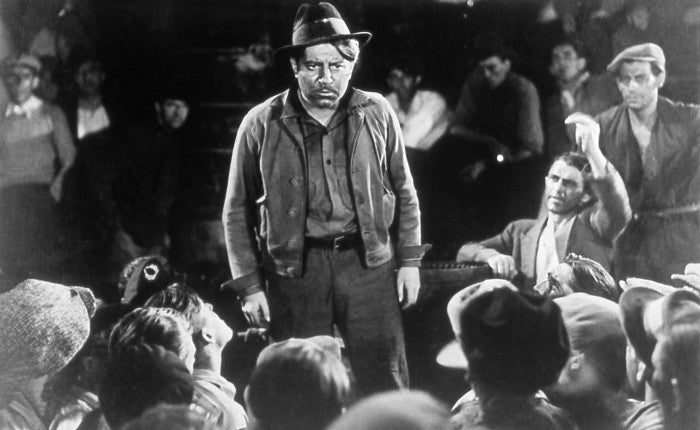
Le Tunnel (1933)
This year’s Berlin Film Festival offered an international retrospective on science fiction films, Future Imperfect, which screened 27 feature films from 10 counties, including such old war horses as War of the Worlds (1953), Invasion of the Body Snatchers (1956), Seconds (1966), THX 1138 (1971), Soylent Green (1973), Alien (1979), Blade Runner (1982) and The Fifth Element (1997). Of greater interest were a number of sci-fi classics from former Communist countries Poland (3 films), Russia, Czechoslovakia and East Germany, two unknown Japanese films, and a number of German sci-fi films. This second focus on non-American sci-fi is discussed in the monograph, Future Imperfect: Science Fiction Film (2017), edited by Rainer Rother and Annika Schaefer. One of the rarer films in the program was Le Tunnel (1933), about the construction of a trans-Atlantic tunnel connecting Europe with Long Island, which I have been trying to track down for decades, because it was produced by German-Jewish filmmakers on the cusp of exile.
Based on Bernhard Kellermann’s 1913 sci-fi novel of the same name, Der Tunnel had been filmed as early as 1915 in Germany by William Wauer (rediscovered and restored 2010). In 1933, Kurt Bernhardt remade the film in Munich at the Emelka Studios in both German and French, simultaneously. The German version, produced by the Bavaria Film company, was released in November 1933, and starred Paul Hartmann, Attila Hörbiger, Olly von Flint, and Gustaf Gründgens, who also played in the French version, while the others were replaced by Jean Gabin, Robert Le Vigan, and Madeleine Renaud, respectively in the French version, produced by Vandor Film, Paris. An English-language version, Transatlantic Tunnel (1935), was directed by Maurice Elvey in Britain two years later, starring Richard Dix, Leslie Banks, Madge Evans and Basil Sydney.

The film opens with engineer Mac Allen convincing a group of American investors to finance a trans-Atlantic tunnel, which then successfully begins construction. One of those investors, Mr. Woolf, soon organizes a campaign of sabotage, while trying to manipulate the stock market in favor of his shipping lines. Allen resigns after an explosion kills numerous workers, but returns after Woolf’s machinations are exposed and successfully completes the project. Unlike the film, which celebrates modernism, Kellermann’s anti-capitalist, anti-Semitic novel argued that the tunnel was obsolete at the moment of completion, given the invention of air travel.
Given those ideological origins, it is not surprising that the film premiered in December 1933, 11 months after Adolf Hitler’s democratic ascension to power. Surprisingly Der Tunnel/Le Tunnel was produced by an equipe of German Jewish filmmakers who would be forced into exile, even as the film was in production, because Joseph Goebbels would declare them illegal aliens. Bernhardt, who both directed and co-wrote the script, received special dispensation to return to Germany from France after emigrating in spring 1933 to direct; he would change his name to Curtis in Hollywood and direct such melodramas as Conflict (1945) and Possessed (1947), after working in France until 1939. The credited scriptwriter of both versions, Reinhart Steinbicker, was a so-called Aryan, but uncredited was Hermann Kosterlitz, whose first directorial effort, Das hässliche Mädchen (1933), would be booed off the stage by Nazi thugs in September 1933; in Hollywood he would become Henry Koster and direct Three Smart Girls (1936), with Deanna Durbin, and many other films. Credited only in the French version was editor Rudi Fehr, who would edit The Life of Emile Zola (1937), and enjoy a 40-year career at Warner Brothers. Not until November 1933 were Jews officially excluded from film production, although most film companies, including the giant UFA, stopped hiring the day of the first anti-Semitic boycott in April.
So, was the film anti-Semitic? Clearly, the character of Woolf, as portrayed by Nazi superstar, Gründgens (the subject of István Szabó’s Academy Award-winning Mephisto, 1981), is an anti-Semitic figure: an unscrupulous, amoral, predatory capitalist and possibly homosexual worshiper of Mammon. Wulf Koepke has argued in The Dark Mirror: German Cinema between Hitler and Hollywood that the structure of the film’s narrative is fascistic: “It consecrates the advent of a unified public sphere whose function is to engineer consent from above, not to express critique from below” (p. 59).

However, Gründgen’s German-accented French also allows for a contrary reading, whereby Woolf is seen as a Nazi provocateur, undermining the spirit of internationalism that the tunnel represents, especially in the scene where the teams drilling from Europe and America meet; a scene very reminiscent of G.W. Pabst’s similar scene in Kameradschaft (1931), when German coal miners break through to rescue trapped French miners.
What this tells us is that a film’s ideological message is always a bit ambiguous, the product of both filmmaker intentionality and audience reception, the latter subject to change over time. Its production history also acknowledges that German Jewry was not a priori anti-Fascist, but still included conservative forces willing to accommodate themselves to the new Hitlerite regime. Bernhardt, e.g., had previously directed Der Rebell (1932) with Luis Trenker, now considered a proto-Fascist film, as well as an overtly anti-abortion film in 1927. On the other hand, the Gestapo ultimately tried to arrest Bernhardt, forcing him to again flee to France. Then as now, the dangers of an anti-democratic Putsch were not yet completely apparent.
< Back to Archival Spaces blog






 Mobile Navigation
Mobile Navigation

